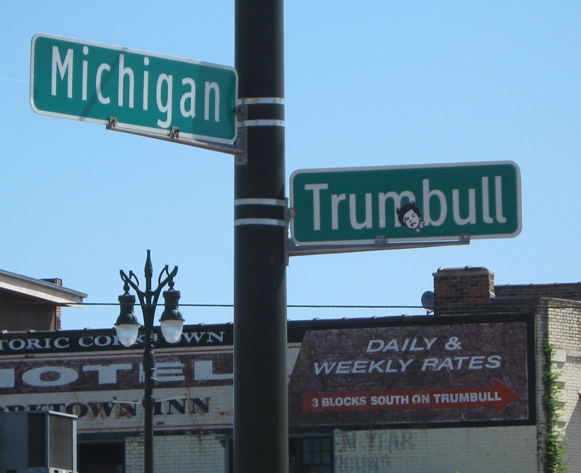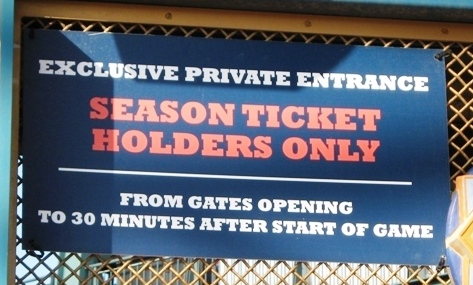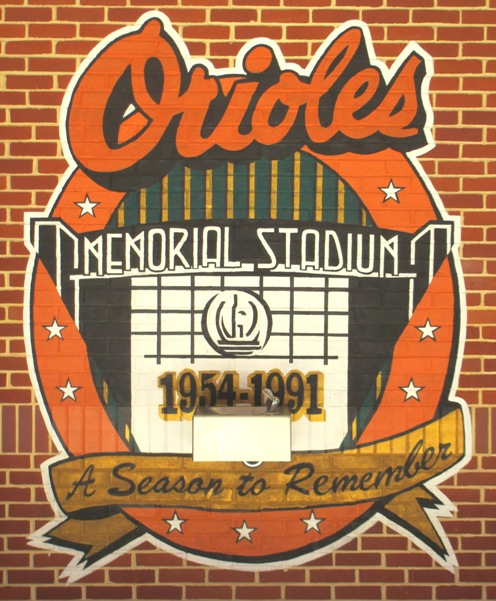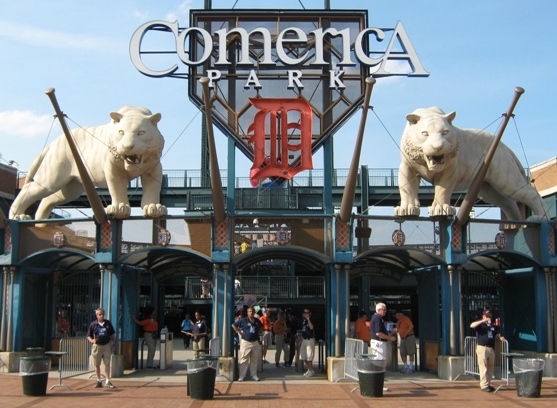“The Final Season” Book Review
Posted by Kurt Smith
I love Comerica Park, but I’ve always had to tell people that with a qualifier: “But I never got to see Tiger Stadium.”
Which isn’t entirely true; I had driven by Tiger Stadium on both of my first two visits to Detroit, in 2001 and 2002, while it was still standing. So at least I saw the outside of it.

An historic corner of Detroit, even if there is just a small field there now.
As I pointed out elsewhere, the reason Comerica is not ranked among the best ballparks, despite my opinion that it should be, is the emotional cost of its construction…the demise of Tiger Stadium, first as the home of the Tigers, then literally, finally being reduced to a neglected and fenced-in field at the corner of Michigan and Trumbull.
Were it not for the memories of folks like Tom Stanton, nowadays you would never know how special that corner was to so many people.

Named from the greatest Tiger not named Cobb.
The Final Season: Fathers, Sons, and One Last Season in a Classic American Ballpark (Honoring a Detroit Legend) isn’t so much about Tiger Stadium and its history—though Stanton does talk about its greatest moments and great players from Cobb to Kaline—as it is Stanton’s own personal reminiscence of his family’s history; to him Tiger Stadium was a constant in the past of a family and neighborhood that went through more than its share of turbulent times.
Stanton sees the classic ballpark as a part of the memories of family members, especially those that had passed on. He tells the stories of grandparents, uncles, and his mother, and how the ballpark was an integral part of his memories of them.
For the book, Stanton, a Tigers fan from birth who was highly upset at his team’s home being replaced, attended all 81 games in the last season of the ballpark.

Better now that there’s more to eat than hot dogs.
Throughout the book he tells stories about members of his family mixed in with stories of Tiger greatness, touching on the game’s results only as an afterthought in each daily entry. He interviews many people employed at the stadium, from announcer Ernie Harwell to Al Kaline to a longtime outside peanut vendor who tragically dies just days after Stanton speaks to him.
The Tigers go through a bad season, but Stanton seems to register more disgust at those who bleat about the so-called “economic realities” that are bringing about the demise of a place he dearly loved.
At one point he takes issue with the idea, which comes across with a Red Sox fan that he meets, that somehow Fenway Park and Wrigley Field were more special and worth preserving than Tiger Stadium was.

Yes, most beloved now…
Tiger Stadium opened the same day Fenway Park did—an hour later, as the Red Sox fan points out to him—and Stanton doesn’t mince words at the thought that Fenway’s history is any better. He uses the words of a fan to dispute the idea that an open air ballpark with a view of the city is somehow superior: “I like being able to forget about the problems outside.” Well put.
Stanton is probably right. It is the sheer amount of passing years that sanctifies Wrigley Field and Fenway Park more than anything else…the idea that so little about going to a ballgame has changed in a century. A game at Tiger Stadium must have been just as reassuring, regardless of whether the ballpark had a big green wall or a hand-operated scoreboard.
A ballpark that has simply aged gives a sense that the rest of the world may be falling apart, but baseball still and always will remain. No matter how bad a team is, a ballpark can’t be around for 80-plus years without amassing indelible memories. Tiger Stadium was no different from Fenway in that regard.

Missed terribly by Orioles fans, even though it stood only 37 years.
One local writer assumed—as many did in Baltimore when the last games were played at Memorial Stadium—that once people saw the new place, they would forget about the old one. That wasn’t really the case in Baltimore, and it certainly didn’t happen in Detroit.
In a reminiscing moment Stanton shares the story of meeting pitcher John Hiller as a kid, who had miraculously moved into his neighborhood. He managed to carry his grocery bags into his apartment for him, meeting Hiller’s wife and children and remembering that he fantasized that they would be friends for life, shortly before he reveals the glum reality that he would not speak with Hiller again until the last game celebration.
Stanton does a masterful job of slowly building up the emotional sentiment to the final game at The Corner. The stories of family become closer to home throughout the book, from the departure of his uncle Herb without a trace to the passing of his mother.
As he and his father are at the final game together in Tiger Stadium and the classic living Tigers take the field one last time, he notices that it’s not the 70 or 80-year olds wiping their eyes, but the generation that followed them.
I won’t give away any more of the last two pages of the chapter, but he beautifully sums up all of his feelings about losing Tiger Stadium, a ballpark that represented his loved ones and kept their memories alive. Throughout Stanton’s description of the final game at Tiger Stadium, one feels his sense of loss, whether one has lost a parent or a cat recently.

Welcome to the suite-filled new Tigers ballpark!
In a bit of an epilogue, Stanton describes attending a few games at Comerica Park, and like many fans, he can’t bring himself to hate it. The end of the epilogue is wistfully touching.
Until reading “The Final Season”, I hadn’t given much thought to the sign that reads “Ernie Harwell Park” on the fence at the untended field where Tiger Stadium once stood.
But Stanton connected the dots for me sharing sentiment from Harwell, saying that Harwell “says it would be best for the neighborhood if the city demolished Tiger Stadium after the team leaves. He fears, otherwise, that the park will sit empty and fall into disrepair, a bulky reminder of better days, and an impediment to the people who live around here in the present, not the past.”

Better than seeing an unused classic ballpark.
Someone may have thought he was right.
Want to save money on baseball tickets, parking and everything else?
Check out my Fan Resources Page!!
If you go to baseball games, you’re going to spend money…on tickets, parking, food and souvenirs, not to mention hotels and travel expenses if you’re going on a baseball road trip.
I’m here to help…check out my Fan Resources page, where I share some of my favorite recommendations for buying tickets, booking baseball parking and saving on travel expenses.
Legal bit: My Fan Resources page contains affiliate links, so you can support this great website while making smart baseball decisions!




